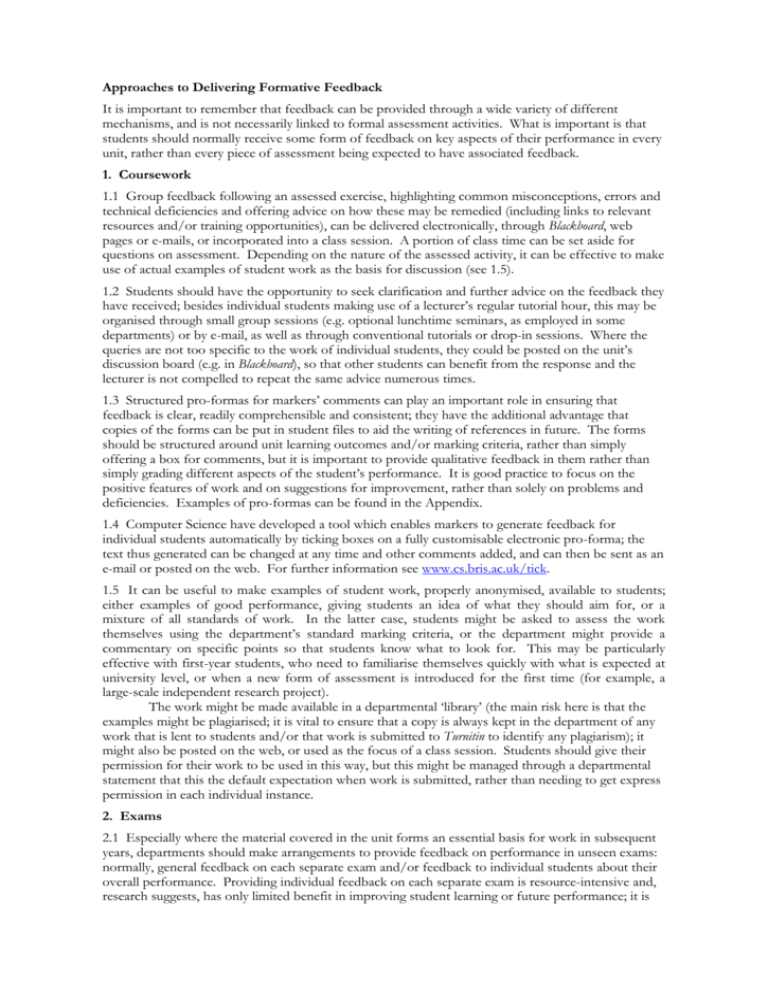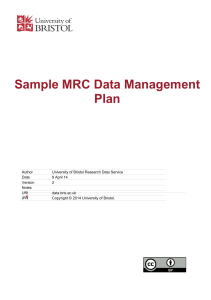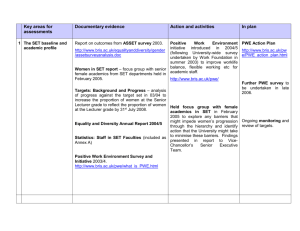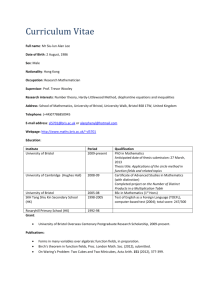to be signed by the student
advertisement

Approaches to Delivering Formative Feedback It is important to remember that feedback can be provided through a wide variety of different mechanisms, and is not necessarily linked to formal assessment activities. What is important is that students should normally receive some form of feedback on key aspects of their performance in every unit, rather than every piece of assessment being expected to have associated feedback. 1. Coursework 1.1 Group feedback following an assessed exercise, highlighting common misconceptions, errors and technical deficiencies and offering advice on how these may be remedied (including links to relevant resources and/or training opportunities), can be delivered electronically, through Blackboard, web pages or e-mails, or incorporated into a class session. A portion of class time can be set aside for questions on assessment. Depending on the nature of the assessed activity, it can be effective to make use of actual examples of student work as the basis for discussion (see 1.5). 1.2 Students should have the opportunity to seek clarification and further advice on the feedback they have received; besides individual students making use of a lecturer’s regular tutorial hour, this may be organised through small group sessions (e.g. optional lunchtime seminars, as employed in some departments) or by e-mail, as well as through conventional tutorials or drop-in sessions. Where the queries are not too specific to the work of individual students, they could be posted on the unit’s discussion board (e.g. in Blackboard), so that other students can benefit from the response and the lecturer is not compelled to repeat the same advice numerous times. 1.3 Structured pro-formas for markers’ comments can play an important role in ensuring that feedback is clear, readily comprehensible and consistent; they have the additional advantage that copies of the forms can be put in student files to aid the writing of references in future. The forms should be structured around unit learning outcomes and/or marking criteria, rather than simply offering a box for comments, but it is important to provide qualitative feedback in them rather than simply grading different aspects of the student’s performance. It is good practice to focus on the positive features of work and on suggestions for improvement, rather than solely on problems and deficiencies. Examples of pro-formas can be found in the Appendix. 1.4 Computer Science have developed a tool which enables markers to generate feedback for individual students automatically by ticking boxes on a fully customisable electronic pro-forma; the text thus generated can be changed at any time and other comments added, and can then be sent as an e-mail or posted on the web. For further information see www.cs.bris.ac.uk/tick. 1.5 It can be useful to make examples of student work, properly anonymised, available to students; either examples of good performance, giving students an idea of what they should aim for, or a mixture of all standards of work. In the latter case, students might be asked to assess the work themselves using the department’s standard marking criteria, or the department might provide a commentary on specific points so that students know what to look for. This may be particularly effective with first-year students, who need to familiarise themselves quickly with what is expected at university level, or when a new form of assessment is introduced for the first time (for example, a large-scale independent research project). The work might be made available in a departmental ‘library’ (the main risk here is that the examples might be plagiarised; it is vital to ensure that a copy is always kept in the department of any work that is lent to students and/or that work is submitted to Turnitin to identify any plagiarism); it might also be posted on the web, or used as the focus of a class session. Students should give their permission for their work to be used in this way, but this might be managed through a departmental statement that this the default expectation when work is submitted, rather than needing to get express permission in each individual instance. 2. Exams 2.1 Especially where the material covered in the unit forms an essential basis for work in subsequent years, departments should make arrangements to provide feedback on performance in unseen exams: normally, general feedback on each separate exam and/or feedback to individual students about their overall performance. Providing individual feedback on each separate exam is resource-intensive and, research suggests, has only limited benefit in improving student learning or future performance; it is normally appropriate only when students would otherwise receive little or no feedback on their individual performance in the course of the unit. 2.2 Unit directors should collate information on student performance on exams for the unit, so that they are in a position to provide general feedback and advice; this is especially important where a paper is marked by a large number of people. As with coursework, group feedback, highlighting common misconceptions, errors and technical deficiencies and offering advice on how these may be remedied (including links to relevant resources and/or training opportunities), can be delivered electronically, through Blackboard, web pages or e-mails, or incorporated into a class session. Evidence suggests that this is particularly effective when students have an opportunity to ask questions and discuss the feedback. Model answers and examples of actual student work can be useful for some subjects; see 1.5. 2.3 When a subject is assessed electronically, it is possible to generate feedback automatically. Depending on the choice of assessment package and the nature of the exercise, the feedback may be limited to which answers were wrong, rather than detailing why they were wrong. 2.4 The purpose of markers’ comments on scripts is to communicate with other markers and with external examiners; while a student has the right, on submitting a formal request via the Secretary’s Office, to see these comments, they are not intended to provide useful feedback and not usually suitable for this purpose. However, departments could adopt a policy that markers should always include a summary on the final sheet of the exam script which could, following de-anonymisation, be distributed to the student’s personal tutors or other appropriate person, so that they can be taken into account in reviewing the student’s performance. 2.5 Departments could develop a mechanism whereby students in particular need of support receive more detailed feedback on their exam performance and suggestions for improvement, delivered e.g. through the personal tutor system. 2.6 For oral and practical exams, it is generally impractical to provide detailed feedback on every aspect of a student’s performance. It can be most effective, as is the practice in various areas of the Medical Faculty, to provide students with feedback on two things they did well and two areas for improvement, balancing positive and negative comments and focusing feedback on future performance. 3. Presentations, Poster Sessions, Practical Sessions etc. 3.1 Here, too, pro-formas can play an important role (see 1.3 and Appendix), indicating to students both what they’ve done well and where they need to improve, as well as in many cases aiding consistency in the marking process. 3.2 Examples of posters can be made available to students; clearly it is technically difficult to make available examples of presentations, but students can be encouraged to reflect on the marking criteria for such exercises when attending lectures. 3.3 Peer assessment can be very effective, either in conjunction with assessment by the lecturer or, for formative purposes, as the sole form of feedback. In larger units, where there is insufficient time for every student to make a presentation in class time, students may be organised into groups with designated speaker, chair, audience and rapporteur (whose job is to sum up the session, including comments on effective presentation practice, to the rest of the group and to the lecturer) and asked to make their own arrangements. This encourages all students, not just those making presentations, to focus on what makes for an effective performance. 3.4 In practical sessions, feedback in the course of the activity or immediately afterwards is generally most effective. When time allows, immediately after a practical assessment students can be talked through the test, offering the opportunity of reviewing the best approaches and/or common errors. 4. Placements 4.1 Most feedback in the course of a placement will be informal and oral, delivered during or immediately after a specific task. However, it is important to supplement this with more formal reviews of progress, both at the end of the placement and at some point or points in the middle. Mechanisms should be put in place to ensure that all relevant people have the opportunity to contribute to the review of a student’s performance. A written record should usually be kept; this may be a detailed pro forma, or a more basic summary (e.g. two things the student did well and two areas for improvement). See for example the system developed for monitoring and assessing industrial placements as part of the Engineering Design programme, www.edes.bris.ac.uk/placements_handbook.htm. 4.2 The review could include an opportunity for the student to record their reflections on their performance, for example by using some form of electronic PDP resource. General advice on PDP can be found at www.bristol.ac.uk/tsu/studentsupport/pdp/, and an example at www.bris.ac.uk/italian/undergrad/3rdyear/pdp.html. 5. Designing Assessment to Support Effective Feedback 5.1 For appropriate topics, students can be given the opportunity to test their understanding of material covered in class by taking on line e-assessment which provide immediate feedback on their responses. Free-standing self-assessment exercises, offering feedback on incorrect responses, can be designed for particular keys skills or sets of knowledge, so that students can take them as often as they wish. This form of assessment driven feedback can provide students with a very valuable learning resource. However care must be taken in both question design and the feedback given, to promote student engagement and learning. The E-Learning Advisers Network webpage offers support and case studies on the use of e-Learning tools: www.bristol.ac.uk/elan. For an example of how e-assessment can be used, see www.epi.bris.ac.uk/undergrad/web/session6_2006/session6_2006.htm 5.2 Within a unit, structured assessment tasks, in which the student begins with relatively straightforward tasks and moves on to more complicated ones (e.g. paper review, evidence analysis, research report), benefitting from feedback on the earlier work, can be effective in developing particular skills and understanding. A ‘portfolio’ approach to assessment, in which the early pieces of work count but can be improved in the light of feedback, can also be effective. 5.3 In some subject areas, essays are used to assess simultaneously a range of learning outcomes from basic knowledge and understanding to higher-level analytical skills. It can be both more effective in terms of delivering feedback and more efficient in terms of marking effort to set up separate tasks to assess different outcomes; see the case study at www.ltss.bris.ac.uk/showcase/casestudy_andrew.html. 6. Supporting Students’ Overall Development 6.1 To encourage students to reflect on and respond to feedback, and in particular to identify areas which need further work, feedback needs to be incorporated into the personal tutor system or equivalent and regular ‘progress review’ meetings. As noted above, those responsible for students’ academic progress might be given copies of comments made on their students’ exam scripts; they might receive copies of feedback pro-formas, putting them in a position to help their students to reflect on their performance across different units. 6.2 Personal Development Planning should encourage students to reflect on their performance, for example by providing a form for reflection on feedback received and/or for reviewing marks and comments. Students should be explicitly encouraged to focus on how to develop their performance in future, rather than simply on their marks. For an example see www.bris.ac.uk/arts/skills/review.doc. 6.3 The assessment for a unit might where appropriate incorporate a reflective journal or some other activity involving the student reflecting on their own performance, including but not restricted to their performance in assessment, and how it might be developed. 6.4 Departments might facilitate the establishment of student study groups, encouraging students to share experiences and comment on one another’s work, and/or mentoring schemes in which older students help first-years acclimatise to the expectations of degree-level study. This is likely to require the provision of resources, above all suitable space, rather than simply encouragement. 7. Developing Further Guidance This guidance is intended to be dynamic, updated to take account of colleagues’ needs and any new developments. If you have any feedback-related issues which aren’t covered here, or if you have developed new approaches to delivering feedback from which your colleagues might learn, please contact the Teaching Support Unit. 8. Further Information www.heacademy.ac.uk/senlef.htm www.heacademy.ac.uk/resources.asp?section=generic&process=filter_fields&type=all&id=1,25&hist ory www.exchange.ac.uk/issue4_contents.asp www.enhancementthemes.ac.uk/events/presentations/20040604.asp September 2007 Appendix: Examples of Feedback Pro-Formas UNIVERSITY OF BRISTOL GRADUATE SCHOOL OF EDUCATION POST GRADUATE CERTIFICATE IN EDUCATION 2006-2007 EDUCATION ASSIGNMENT 2 SPRING TERM ORAL PRESENTATION ASSESSMENT FORM (Strands 2 and 4) Student: ................................................................ Topic: ...................................................................................................................................................... CRITERIA & COMPONENTS PRODUCT Communication Structure COMMENTS VG G S C INVESTIGATION Planning/preparation Coverage Reference EDUCATIONAL ISSUES Understanding Analysis Accuracy LEARNING Presenter’s Audience’s Overall Grade Transfer these grades to Education Assignment 2 ‘top sheet’ Summary Comment Student’s response: Signed (Student): ........................................ C R I T E R I A Product Investigation Educational Issues Learning (Assessor): ................................................... Date: ................. Communication: clarity, vocal delivery, pace, fluency, use of visual aids Structure and sequencing of material Planning and preparation of investigation Coverage of chosen topic Reference to contextual legislation/statutory frameworks, etc. Understanding of issues/perspectives Evidence of analysis/evaluation of issues Accuracy of information/knowledge presented Evidence of personal learning Value of presentation to audience (actual or virtual) Grading: VG = very good, G = good, S = satisfactory, C = cause for concern UNIVERSITY OF BRISTOL GRADUATE SCHOOL OF EDUCATION POST GRADUATE CERTIFICATE IN EDUCATION 2006-2007 EDUCATION ASSIGNMENT 2 SPRING TERM ORAL PRESENTATION PEER ASSESSMENT FORM Student making presentation: ................................................................ Topic: ...................................................................................................................................................... Student making peer assessment: ……………………………………….. __________________________________________________________________________________ How well did the student communicate the content of the presentation? Was the presentation made accessible and relevant to the audience? How thoroughly had the student investigated the topic? Was an appropriate range of educational issues addressed? Was there good evidence of what the student had learned? How do you think the presentation could have been improved? Student assessor: Please give Student and University copies of this form to the PT ESSAY EVALUATION FORM NAME: DEGREE: UNIT: SUBMISSION DATE: (not deadline date) TITLE: NUMBER OF WORDS: TO BE SIGNED BY THE STUDENT I DECLARE THAT THIS ESSAY IS ENTIRELY MY OWN WORK AND THAT IT DOES NOT CONTAIN ANY PLAGIARISED MATERIAL SIGNED: …………………………………………………………. DATE: …………………… Information GOOD POOR Structure & Argument GOOD POOR Use of Evidence GOOD POOR Quality of Writing GOOD POOR Academic Conventions GOOD POOR sound, relevant coherent, logical, sophisticated, original, probing argument well illustrated lucid, elegant, punctuated correctly, no errors of spelling or syntax citations consistently referenced and included in bibliography, titles of works underlined etc. muddled, repetitive, mechanical, over-dependent on secondary material poorly illustrated clumsy, multiple spelling errors, poorly punctuated and expressed bibliography not in alphabetical order, works mentioned not underlined, referenced inadequately Best Features of Essay: Features which would improve your mark: Mark: sketchy, irrelevant, inaccurate Marker’s Initials:








